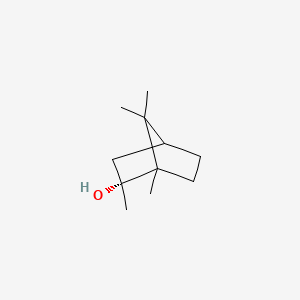| Authors | Title | Published | Journal | PubMed Link |
|---|---|---|---|---|
| Zhong F et al. | The management of undesirable cyanobacteria blooms in channel catfish ponds using a constructed wetland: Contribution to the control of off-flavor occurrences. | 2011 | Water Res. | pmid:22000715 |
| Omür-Ozbek P et al. | Determining human exposure and sensory detection of odorous compounds released during showering. | 2011 | Environ. Sci. Technol. | pmid:21141853 |
| Jo CH et al. | Simultaneous degradation of disinfection byproducts and earthy-musty odorants by the UV/H2O2 advanced oxidation process. | 2011 | Water Res. | pmid:21392812 |
| Ariyawutthiphan O et al. | Crystallization and preliminary X-ray crystallographic study of a methyltransferase involved in 2-methylisoborneol biosynthesis in Streptomyces lasaliensis. | 2011 | Acta Crystallogr. Sect. F Struct. Biol. Cryst. Commun. | pmid:21393856 |
| Srinivasan R and Sorial GA | Treatment of taste and odor causing compounds 2-methyl isoborneol and geosmin in drinking water: a critical review. | 2011 | J Environ Sci (China) | pmid:21476334 |
| Wang Z et al. | Genes associated with 2-methylisoborneol biosynthesis in cyanobacteria: isolation, characterization, and expression in response to light. | 2011 | PLoS ONE | pmid:21490938 |
| Giglio S et al. | Biosynthesis of 2-methylisoborneol in cyanobacteria. | 2011 | Environ. Sci. Technol. | pmid:21174459 |
| Deng X et al. | Simultaneous determination of eight common odors in natural water body using automatic purge and trap coupled to gas chromatography with mass spectrometry. | 2011 | J Chromatogr A | pmid:21565349 |
| Petersen MA et al. | Chemical and sensory quantification of geosmin and 2-methylisoborneol in rainbow trout (Oncorhynchus mykiss) from recirculated aquacultures in relation to concentrations in basin water. | 2011 | J. Agric. Food Chem. | pmid:22040367 |
| Laaks J et al. | In-tube extraction of volatile organic compounds from aqueous samples: an economical alternative to purge and trap enrichment. | 2010 | Anal. Chem. | pmid:20722393 |
| Chen J et al. | A systematic study on spatial and seasonal patterns of eight taste and odor compounds with relation to various biotic and abiotic parameters in Gonghu Bay of Lake Taihu, China. | 2010 | Sci. Total Environ. | pmid:21056900 |
| Matsui Y et al. | Geosmin and 2-methylisoborneol adsorption on super-powdered activated carbon in the presence of natural organic matter. | 2010 | Water Sci. Technol. | pmid:21099055 |
| Freeman KS | Harmful algal blooms. Musty warnings of toxicity. | 2010 | Environ. Health Perspect. | pmid:21465740 |
| Hsieh ST et al. | Biodegradation of MIB and geosmin with slow sand filters. | 2010 | J Environ Sci Health A Tox Hazard Subst Environ Eng | pmid:20473805 |
| Chen YM et al. | In situ measurement of odor compound production by benthic cyanobacteria. | 2010 | J Environ Monit | pmid:20445867 |
| Parinet J et al. | Influence of water quality on the presence of off-flavour compounds (geosmin and 2-methylisoborneol). | 2010 | Water Res. | pmid:20696452 |
| Dixon MB et al. | Nanofiltration for the removal of algal metabolites and the effects of fouling. | 2010 | Water Sci. Technol. | pmid:20220241 |
| Guttman L and van Rijn J | 2-Methylisoborneol and geosmin uptake by organic sludge derived from a recirculating aquaculture system. | 2009 | Water Res. | pmid:18986667 |
| Mochida K | Evaluation of the cytotoxicity of geosmin and 2-methylisoborneol using cultured human, monkey, and dog cells. | 2009 | Biocontrol Sci | pmid:19344097 |
| Kutschera K et al. | Photoinitiated oxidation of geosmin and 2-methylisoborneol by irradiation with 254 nm and 185 nm UV light. | 2009 | Water Res. | pmid:19303132 |
2-Methylisoborneol
2-methylisoborneol is a lipid of Prenol Lipids (PR) class. The involved functions are known as Medical Device Material Degradation and volatile substances. The associated genes with 2-Methylisoborneol are oxytocin, 1-desamino-(O-Et-Tyr)(2)-.
Cross Reference
Introduction
To understand associated biological information of 2-Methylisoborneol, we collected biological information of abnormalities, associated pathways, cellular/molecular locations, biological functions, related genes/proteins, lipids and common seen animal/experimental models with organized paragraphs from literatures.
What diseases are associated with 2-Methylisoborneol?
There are no associated biomedical information in the current reference collection.
No disease MeSH terms mapped to the current reference collection.
PubChem Associated disorders and diseases
What pathways are associated with 2-Methylisoborneol
There are no associated biomedical information in the current reference collection.
PubChem Biomolecular Interactions and Pathways
Link to PubChem Biomolecular Interactions and PathwaysWhat cellular locations are associated with 2-Methylisoborneol?
There are no associated biomedical information in the current reference collection.
What functions are associated with 2-Methylisoborneol?
Related references are published most in these journals:
| Function | Cross reference | Weighted score | Related literatures |
|---|
What lipids are associated with 2-Methylisoborneol?
There are no associated biomedical information in the current reference collection.
What genes are associated with 2-Methylisoborneol?
Related references are published most in these journals:
| Gene | Cross reference | Weighted score | Related literatures |
|---|
What common seen animal models are associated with 2-Methylisoborneol?
There are no associated biomedical information in the current reference collection.
